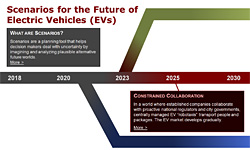Constrained Collaboration Scenarios for the Future of Electric Vehicles September 2018
Want more free featured content?
Subscribe to Insights in Brief

Scenario Overview:
Constrained Collaboration
Established automakers collaborate with proactive national regulators and city governments to transform many of the world's wealthiest urban centers—especially those in China—into smart-city hubs brimming with interconnected, centrally managed EV "robotaxis" that transport people and packages. The rest of the EV market develops gradually in accordance with regulation-driven industry timelines.
In This Scenario:
- Regulatory incentives and mandates both stimulate and constrain EV adoption in complex ways. Adoption growth is tied strongly to some automakers' equally complex efforts to transform themselves into transportation-services companies.
- Vast fleets of autonomous city EVs end up becoming the fastest-growing but least-profitable market segment.
- Operating autonomous EV fleets in cities offers many opportunities to profit indirectly through in-vehicle services offerings and logistics services and from leveraging the vast data pools that vehicles gather during operation.
- Many of the most desirable locales for fleet operation end up becoming exclusive fiefdoms of single providers, who become very difficult to displace, in part because their fleet-generated data pools are almost impossible for newcomers to replicate.
- An abundance of regulation-driven standards for charging technologies leads to steady development of independent EV "filling stations" that frequently repurpose existing gas-station real estate.
- Abundant charging does not accelerate frustratingly modest EV sales growth to individual consumers.